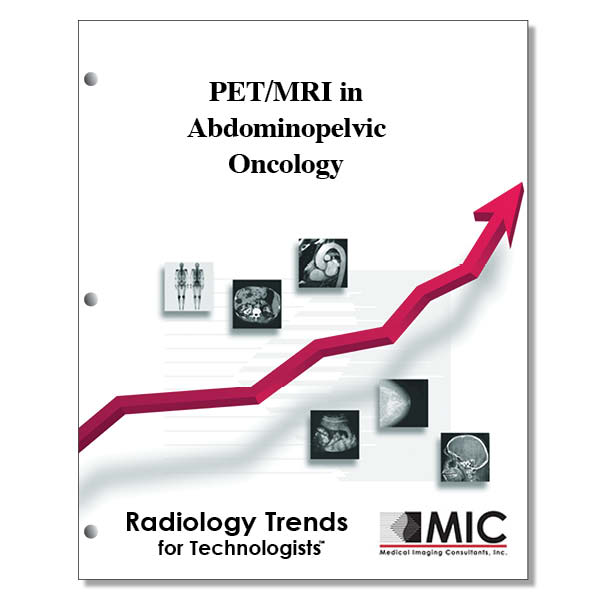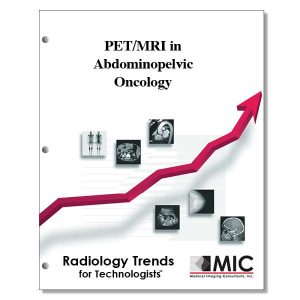

PET/MRI in Abdominopelvic Oncology
Advantages and disadvantages of PET/MRI, as compared with those of PET/CT, are outlined, and applications of PET/MRI in abdominopelvic oncology are presented.
Course ID: Q00711 Category: Radiology Trends for Technologists Modalities: CT, MRI, PET, Radiation Therapy2.25 |
Satisfaction Guarantee |
$24.00
- Targeted CE
- Outline
- Objectives
Targeted CE per ARRT’s Discipline, Category, and Subcategory classification:
[Note: Discipline-specific Targeted CE credits may be less than the total Category A credits approved for this course.]
Magnetic Resonance Imaging: 0.25
Procedures: 0.25
Body: 0.25
Nuclear Medicine Technology: 0.25
Procedures: 0.25
Endocrine and Oncology Procedures: 0.25
Registered Radiologist Assistant: 0.25
Procedures: 0.25
Abdominal Section: 0.25
Radiation Therapy: 0.25
Patient Care: 0.25
Patient and Medical Record Management: 0.25
Outline
- Introduction
- Technical and Workflow Considerations for PET/MRI
- PET/MRI versus PET/CT
- Pearls and Pitfalls of PET/MRI
- Prostate Cancer
- Neuroendocrine Tumors
- Rectal Cancer
- Pancreatic Cancer
- Hepatobiliary Cancer
- Gynecologic Cancers
- Other Tumors
- Conclusion
Objectives
Upon completion of this course, students will:
- list limitations in the acquisition and interpretation of PET/CT data
- identify the date that PET/MRI was first approved for clinical use in the Unites States
- list the imaging vendors that sell commercial PET/MRI systems in the Unites States
- describe the hardware components of current PET/MRI systems
- list the tissue types that are identified by Dixon MRI sequences used for attenuation correction
- describe the general guidelines for PET/MRI acquisitions
- list practical challenges that have limited widespread adoption of PET/MRI into clinical practice
- list the benefits of PET/MRI over PET/CT
- compare the sensitivity of PET/MRI and PET/CT
- identify tissue types that are not accounted for by MRAC images
- list common causes of dephasing on MRAC images that can result in PET signal loss
- identify the most common noncutaneous malignancy in men
- describe the current NCCN imaging recommendations for patients with high-risk prostate cancer
- describe the physical half-life carbon-11 PET radiotracers
- list known limitations of PET imaging of prostate cancer using 18F fluciclovine
- list the tissue types in the body from which NETs most commonly arise
- list radiotracers that have been used for noninvasive diagnosis and staging of patients with NETs
- describe an abbreviated MRI protocol for hepatic metastases from NETs
- identify isotopes used for peptide receptor radionuclide therapy for NETs
- identify the most common malignancy that affects the digestive system
- describe the modality that is typically used to identify and diagnose rectal cancers
- list imaging findings that make it difficult to diagnose lymph node metastases from rectal cancer at MRI
- identify radiotracers that can increase reader confidence and detection of pelvic nodal metastases in patients with rectal cancer
- list the MRI sequences that may improve detection of hepatic metastases from rectal cancer
- describe the second most common malignancy of the digestive system
- describe the utility of FDG PET in the staging of newly diagnosed pancreatic cancer
- describe the standard of care treatment for patients with newly diagnosed pancreatic adenocarcinoma
- describe challenges affecting CT and MRI imaging following treatment for pancreatic cancer
- list examples of hepatobiliary cancers
- identify imaging modalities that form the cornerstone for hepatocellular cancer diagnosis and monitoring response to treatment
- identify PET radiotracers that target fibroblast activity
- list the most commonly diagnosed gynecologic cancers
- identify the best imaging modality for identifying primary gynecologic cancer tumors
- identify the best imaging modality for identifying gynecologic cancer lymph node metastases
- describe clinical symptoms that may indicate malignant transformation of neurofibromas
